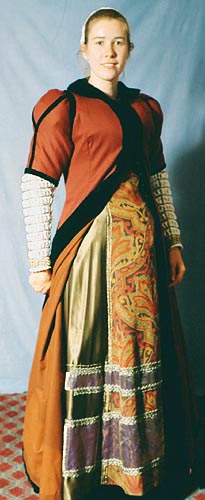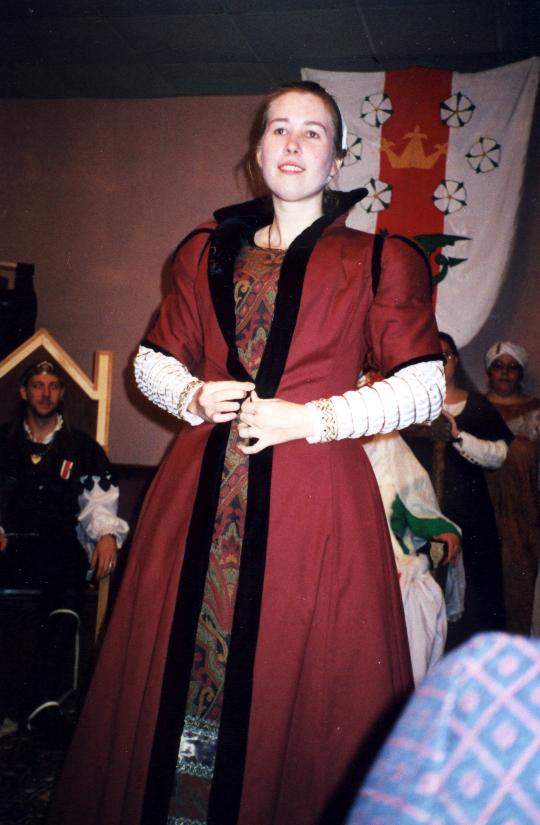

This ensemble was inspired by a sketch of london gentlewomen created by Lucas de Heere in 1570.
The guards are the same size and placement as on the original. Mine are of brown/black changeable taffeta covered with a layer of gold/purple silk metallic organza. A sage-green silk gimp trim outlined the guards top and bottom, and a narrow, metallic gold braid was sewn on the edges of the forepart and around the skirt, above and below the guards, with the placement of the braid the same as on the original.
The neck, armholes and back opening are bound in bias-cut brown taffeta. The lacing holes at the armhole and down the center back were made with an awl and bound with brown silk thread. Aside from the construction seams, all edge finishing, applique of guards and trim and other work was sewn by hand with silk thread.
The finished garment, due to the extra taffeta lining and canvas interlining, was quite heavy and substantial. The weight of the skirt made it stand out, even without the use of a hoopskirt.

The sleeves puffs were of white china silk. I couldn't afford stiff peau de soie, and so backed the silk with "Touch of Gold" interfacing, which added body and kept the edges from fraying, while being almost invisible to the eye. The base they were mounted on was purple/gold metallic silk organza with a linen backing. The inner lining was cream-colored linen.
The base layer and the puffed layer of the sleeves were both cut in one piece. The top half was whole, while the bottom split into two curved sections; this is seen in later 16th century sleeve patterns.
I drew a series of horizontal and vertical lines on the back of the fabric. The horizontal lines were the bands, and the vertical lines the slashes. Using an exacto knife, I cut the vertical slashes to within 1/8 an inch of the horizontal lines.
The puffs were mounted to the base layer and sewn down along the horizontal lines. Then the edges of each strip were caught back in the middle. Gold trim was sewn over the horizontal stitching lines, and small, looped pickadils of white silk sewn to the wrists of the sleeves. All sewing was done by hand with gold-colored silk thread.
The sleeves are complicated. The base is a close-fitting sleeve of canvas, to which a network of poly-boning was sewn. This was covered with a layer of batting, and this covered with the outer fabric. I tried using shaped buckram, but found that it wouldn't keep its shape when wet. Stuffing the sleeves created a lumpy shape that wasn't smooth and clean.
The gown closes up the front with inch-wide hooks and eyes (obtained from Greenberg & hammer.) It can be worn closed to the waist, in which case it's quite form-fitting, or hooked from the neck to upper torso, which turns it into a loose gown or ropa.

All Pictures © 2000 by Don McLeane